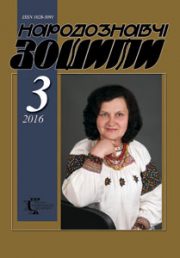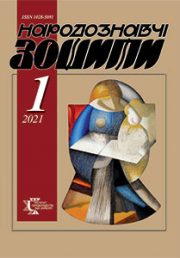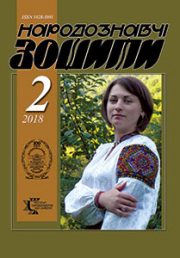The Ethnology Notebooks. 2019, № 3 (147), 715—731
UDK 39:643:747(477.86-11)”189/193″
DOI https://doi.org/10.15407/nz2019.03.715
INTERIOR OF POKUTTYA DWELLING (the second half of the 19th — the beginning of the 20th century)
RADOVYCH Roman
ORCID ID: http://orcid.org/0000-0002-1900-8948
Doctor of Sciences in History, Senior Researcher
of the Institute of Ethnology
of the National Academy of Sciences of Ukraine,
in the Department of Historical Ethnology,
15, Svobody Avenue, 79000, Lviv, Ukraine
Contacts: е-mail: radovychroman@gmail.com
Abstract. The typical interior of the village house of Ukrainians, which had only one living space, was formed over the centuries and characterized by a certain set of objects, their location, as well as the system of heating and lighting. According to scientists, the internal structure of the Ukrainian house (nineteenth century — R.R.) in all the regions, starting from the western part of the Kurshyna and Voronezhchyny, and ending with the eastern slopes of the Carpathians, is extremely similar. F. Vovk also noted some minor local variations of the interiors’. Therefore, the elucidation of the local specificity of the internal arrangement of the settlements of certain ethnographic regions is very relevant today. The author aims to find out the peculiarities of the internal arrangement of settlements in Pokuttya, to find out their common Ukrainian features and local specifics. The object of research is the traditional habitation of Pokutians, and the subject is its interior. The methodological basis of the study is the principle of historicism in combination with the elements of structural and functional analysis and the use of basic methods of ethnological science. The internal arrangement of the people’s homes has never been the subject of special studies. In the few publications related to the housing and construction culture in this area, this aspect is covered by the authors rather briefly, without proper analysis, therefore the author’s own materials based on researches are the basis of the work.
The internal equipment of village house in Pokuttya territory was characterized by a certain set of objects, their location, as well as a system of heating and lighting, which in general was typical for the whole of Ukraine. At the entrance to the house, on one side, in the corner there is an oven, on the other side there is a set of shelfs for dishes, between the stove and the communal wall there is stationary or mobile bed. In the corner, a diagonally opposite to oven is placed a table (or a chest), we can find icons above of it. Along the porous and dominant walls there were benches, between the table and the floor there is a chest (sometimes the last replaced the table), and next to the table there is a movable chair. At the same time, under the influence of certain factors, we observe certain local variations in the interior design. In the first place, the specifics of the interior of Pokutsky’s dwelling were manifested as a result of the influences (combination) of the Podillya and Carpathian (inherently Hutsul) traditions. At the same time, kurna heating system at Pokuttya was eliminated by the middle of the nineteenth century, which liberated the premises from smoke, in the domestic equipment of local housing of the investigated period (in contrast to mountainous regions) decorative fabrics, painted ceramics, modern furniture were widely used. The walls were painted or washed in hills regions. Colored drawing and painting were used when decorating the oven, and sometimes it was decorated with decorative tiles.
Keywords: Pokuttya, dwelling, interior, table, bed, oven, set of shelfs for dishes, shelf.
Received 10.04.2019
REFERENCES
Vovk, Hv.(1995). Ethnographic features of the Ukrainian people. In Vovk, Hv. Studies on Ukrainian ethnography and anthropology (pp. 39—218). Kiev: Art [In Ukrainian].
Radovych, R. (2017). Pokuttya traditional accommodation: technique and technology of wall construction (19th — first half of 20th centuries). Plisnensky antiquities, 2, 27—61. Lviv. [In Ukrainian].
Derkach, I., & Pankov, M. (1994). Manor on Pokuttya (end of the XIX — early XX century). Ivano-Frankivsk [In Ukrainian].
Kolberg, O. (1882). Penetration: ethnographic picture (Vol. 1). Krakow: In the printing house of the Jagellonian university [in Polish].
Mroczko, Fr. X. (1897). Њnatyсszczyzna (Part 1). Lviv: From the printing house of Wіadysіaw Јoziсski [in Polish].
Yakymovych, A.I. Report on the scientific expedition to Pokuttya; 7.06 — 15.06.1978. In The Archive of LMNAP. F. Materials of expeditions. Exp. ЗВ—11. 45 arcs. [In Ukrainian].
Yakymovych A. I. Report on the scientific expedition to Pokuttya; 17.06 — 25.06.1976. In The Archive of LMNAP. F. Materials of expeditions. Exp. ЗВ—17. 41 arcs. [In Ukrainian].
Yakymovych A.I. Report on the scientific expedition to Pokuttya. 1984. In The Archive of LMNAP. F. Materials of expeditions. Exp. ЗВ—53. 24 arcs. [In Ukrainian].
Falkowski, J. (1938). The north-eastern border of the Hutsul region. Ethnographic work, 4. Lviv: Publisher of the Folklore Society in Lviv [In Polish].
Yakymovych, A. (1998). Traditional folk dwelling of Pokuttya of the late nineteenth and early twentieth centuries. Proceedings. Museum of Folk Architecture and Life in Lviv, I, 58—63 [In Ukrainian].
Radovych, R. (2017). Polissya dweling: cultural and genetic origins and evolutionary processes. Lviv. [In Ukrainian].
Bayburin A.(1983). Dwelling in the rites and performances of the Eastern Slavs. Leningrad: Science [In Russian].
Yakymovych A. (2001) Use of clay in the national construction of Bukovyna and Pokuttya (the end of the 19th — early 20th centuries) The Ethnology Notebooks, 3, 555—558 [In Ukrainian].
Radovych, R. (1996). Rural housing of the late 19 — early 20 centuries in the south of Podillya (based on materials from Borshchiv district). Chronicle of Borshchivschyna: Historical and Local Studies Collection, Issue VІІІ, 58—66. Borschiv: Source [In Ukrainian].
Кosmina, T.V. (1980). Rural habitation of Podillya (end of 19 — 20 centuries): Historical and ethnographic research. Kiev: Scientific Opinion [In Ukrainian].
Borenko N. (2013). The attrition of ceramic products is an important factor in research work (for example, the «pottery» and «artistic industries» stock groups of the Museum of Folk Architecture and Life in Lviv. The materials of the first International Scientific and Practical Conference, Scientific Collection. (pp. 23—34). Lviv: Apriori. Edition. 1 [In Ukrainian].
Kolupayeva A. (2006). Ukrainian tiles of the nineteenth and early twentieth centuries. History. Typology. Ikonognrafiya. Ensemblivist. Lviv: Institute of Ethnology of the National Academy of Sciences of Ukraine [In Ukrainian].
Yakymovych A.(2008). The interior of the people’s residence of Bukovina (the end of the nineteenth and the beginning of the twentieth century). Proceedings. Museum of Folk Architecture and Life in Lviv, ІI, 72—88 [In Ukrainian].
Kishchuk T. (1987) Interior. In The folk architecture of the Ukrainian Carpathians of the 15th—20th centuries (pp. 110—125). Kiev: Scientific Opinion [In Ukrainian].
Shukhevych V. (1997). Hutsulshchyna (Vol. 1—2). Verkhovyna (reprint edition 1899 and 1901 years) [In Ukrainian].
Fedak P. M. (2005). Housing of Ukrainians from Transcarpathia of the 18th — 20th centuries. Uzhgorod: Grazhda. [In Ukrainian].
Mohitich, I.R., & Kischuk T. P. (1987). Manor house, home, interior. In Hutsulshchyna Historical and ethnographic research (pp. 165—178). Kiev: Scientific Opinion. [In Ukrainian].
Sergeeva, M. (1999). Formation of the interior of medieval housing. In Ukrainian: historical and ethnographic monography in two books (Vol. 2, pp. 65—74). Opishne: Ukrainian Genre Studies [In Ukrainian].
Olyanchyn D. (1937). Description of the Travel of the Swedish Ambassador to Ukraine1656-1657 In The Notes of the NTSh. (Vol. СLІV, pp. 41–69). Lviv: NTSh. [In Ukrainian].
Syvak V. (2007). Spill. In Small Encyclopedia of Ukrainian Ethnology (рр. 317) Lviv: Institute of Ethnology of the National Academy of Sciences of Ukraine. [In Ukrainian].







